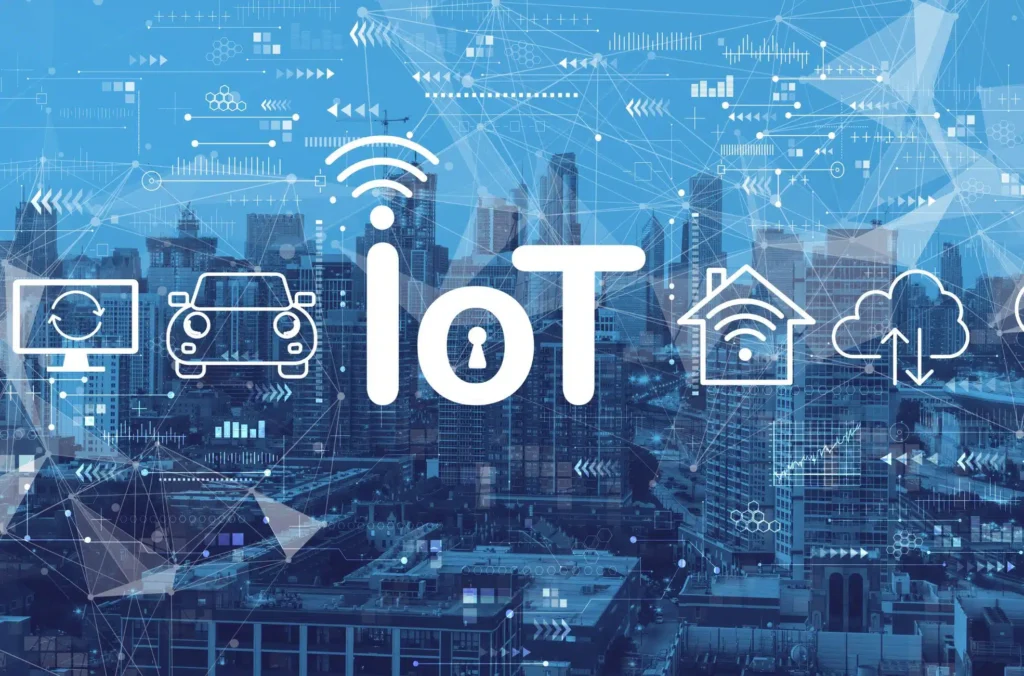Home > Business Software and Tools > What Is IoT and Its Impact on The Future Of Business
What Is IoT and Its Impact on The Future Of Business
May 12, 2024 | Business Software and Tools

The Internet of Things (IoT): Transforming Business and Society
The Internet of Things (IoT) is redefining the fabric of business and society through its vast network of interconnected devices. This innovation is not only reshaping how we interact with our gadgets but also has profound implications for business operations, efficiency, and customer engagement. By enabling the seamless exchange of data, IoT is unlocking unprecedented opportunities for companies to foster smarter, more responsive, and more sustainable practices.
The potential for transformation is immense, ranging from supply chain logistics to retail experiences. As we delve into the intricate world of IoT, we’ll explore its key components, communication protocols, and the myriad ways it’s already enhancing our daily lives. Additionally, we’ll examine the challenges and prospects ahead, charting the course for businesses ready to embrace the digital transformation that IoT promises.
What Is the Internet of Things (IoT)?
The Internet of Things (IoT) is a groundbreaking development that has begun to deeply integrate into our daily lives. IoT refers to the extensive network of devices, or “things,” equipped with sensors, software, and other technologies that connect and exchange data with other devices and systems over the internet.
This interconnectedness bridges the gap between the physical world and computer-based systems, leading to improved efficiency, economic benefits, and reduced need for human intervention.
Key Components of IoT Systems
At the core of IoT systems are several essential components that enable their functionality:
Sensors: Affordable and reliable sensors are central to IoT technology. They collect data from the environment, which can then be used to make decisions or provide insights.
Network Protocols: Data collected by sensors is transmitted using various network protocols designed to facilitate efficient data transfer between devices and the cloud.
Cloud Platforms: These platforms provide the infrastructure necessary for scaling IoT solutions without the need to manage physical hardware. They store vast amounts of data and support advanced analytics.
Machine Learning and Analytics: Advances in machine learning and analytics allow businesses to derive insights more quickly and conveniently from the data stored in the cloud.
Natural Language Processing (NLP): Modern IoT devices increasingly incorporate NLP, making them more interactive and user-friendly.
How IoT Devices Communicate
Communication between IoT devices involves a complex array of interactions and protocols, each chosen based on specific application requirements:
Wi-Fi: Suitable for IoT devices where power supply is not a constraint and processing requirements are manageable.
Bluetooth and Z-Wave: Ideal for home automation due to their optimization for low-power and low-bandwidth communication.
LoRaWAN: Preferred for long-range communication with minimal data transfer needs.
Cellular Networks: Protocols like NB-IoT and LTE-M support battery-operated devices, enabling extended operational periods without frequent recharging.
Radio Communication: Various radio protocols cater to different applications and requirements.
Examples of IoT in Everyday Life
IoT technology has significantly transformed various aspects of daily life:
Healthcare: Wearable IoT devices monitor health metrics, allowing both individuals and healthcare providers to track and manage health remotely.
Retail: IoT applications streamline inventory management, enhance customer experiences, optimize supply chains, and reduce operational costs.
Automotive: IoT promises improvements in vehicle performance, safety, and user experience.
Transportation and Logistics: Enhanced tracking and management systems increase efficiency and reliability.
Public Sector: IoT informs citizens about disruptions and monitors utilities like water, power, and sewer services.
Healthcare Facilities: Asset monitoring optimizes equipment usage and maintenance.
Worker Safety: IoT technology improves safety across industries by monitoring environmental conditions and ensuring compliance with safety regulations

IoT’s Role in Digital Transformation
Enhancing Data Collection
IoT has revolutionized data collection by enabling the acquisition of vast amounts of data from a wide array of devices. These devices, embedded with sensors, continuously capture and transmit data to cloud servers. This capability is crucial for digital transformation, as it provides organizations with deeper insights into their operations and customer behaviors. With an estimated 55.7 billion connected IoT devices expected by 2025, the potential for data-driven business strategies is immense.
Integrating with AI and Machine Learning
The convergence of IoT with AI and machine learning (ML) is advancing digital transformation efforts. IoT provides the raw data that AI and ML algorithms need to learn and make informed decisions. This synergy is transforming businesses by offering advanced analytics and insights that enhance productivity and operational efficiency. AI’s analysis of IoT-generated data enables optimized operations, strategic resource allocation, and predictive maintenance by forecasting future patterns based on historical data.
Automating Processes and Reducing Human Error
IoT is pivotal in automating processes and reducing human error, which are key elements of digital transformation. Automation of routine tasks through IoT allows human workers to focus on more complex and creative activities. This shift not only improves operational efficiency but also reduces the frequency of errors associated with manual processes. The widespread adoption of IoT devices is enabling businesses of all sizes to embrace automation, leading to enhanced data analysis, identification of new opportunities, and increased revenue potential.
IoT’s Impact on Decision Making
IoT has a significant influence on organizational decision-making. The extensive data generated by IoT devices provides critical insights into various aspects of operations, enhancing understanding of consumer patterns and refining production processes. The ability to swiftly adapt to market shifts and consumer demands fosters a culture of agility and innovation. As organizations increasingly leverage IoT, the capacity for informed decision-making becomes a hallmark of sustained success and market leadership.
Business Operations and IoT
IoT in Supply Chain Management
IoT is transforming supply chain management by improving visibility and control over logistics processes. Connected shipping containers and sensors enable real-time tracking of shipments, optimizing routes and enhancing security measures. Innovations like Container2.0 integrate IoT with advanced analytics to offer eco-friendly logistics solutions. For example, pharmaceutical distributors in South Korea use IoT to ensure the safe delivery of vaccines and medicines. IoT also impacts asset management across global networks, with services like Visilion tracking items from spare parts to medical equipment.
Smart Devices in Manufacturing
The manufacturing sector is experiencing a digital transformation through IoT, shifting from manual data logging to precision monitoring with sensors. These sensors provide real-time data on various manufacturing processes, detecting resource leaks and offering proactive maintenance alerts. IoT technologies enable continuous monitoring of assembly lines, improving efficiency and reducing equipment breakdowns. Energy management and predictive maintenance are also enhanced by IoT, leading to substantial energy savings and optimized production cycles. Digital twins further aid in visualizing complex machinery and operations before implementation, improving planning and workflow.
IoT Solutions in Retail
In retail, IoT is revolutionizing inventory and asset management. Technologies such as Bluetooth beacons, GPS, and RFID enable real-time tracking of assets’ location, condition, and movement. This granular tracking improves inventory management and enhances the customer shopping experience by facilitating technologies that eliminate traditional checkouts and queues. IoT sensors in warehouses boost inventory tracking and picking performance, while environmental sensors monitor storage conditions to ensure the safety of perishable goods. Automation through IoT speeds up goods handling and introduces innovative shopping technologies, transforming the retail landscape.
Real-Time Analytics and Monitoring
Real-time analytics, empowered by IoT, allows businesses to make immediate decisions and operational adjustments. Live dashboards connected to data streams provide insights into current business activities, detecting trends or anomalies as they occur. This capability is valuable in scenarios ranging from marketing campaigns to fraud detection in banking. The integration of data streams from social media and public sources with AI and ML enhances the value of real-time analytics across industries. IoT devices enable continuous data feedback, informing immediate actions in areas such as energy management, traffic optimization, and agricultural monitoring. IoT monitoring software aids in efficient infrastructure monitoring, workforce supervision, and resource utilization, ultimately enhancing security and risk mitigation.
The versatility of IoT services, including health monitoring and smart documentation management, ensures that businesses can keep pace with evolving market demands and deliver superior products and services.

Challenges and Considerations
Security Risks Associated with IoT
As the number of connected IoT devices increases, so do the security risks. Since 2008, vulnerabilities in IoT devices have been a growing concern, with malware attacks becoming more sophisticated. Attackers often exploit weak passwords and network service vulnerabilities, with Telnet being a frequent target for brute-force attacks. For instance, early 2023 saw a prevalence of these types of attacks.
Once attackers gain access, they can execute commands, inject malware, and co-opt devices for malicious purposes. Notable activity in this realm has been observed from countries including China, India, and the United States. Default passwords, sometimes hard-coded by manufacturers, contribute to these vulnerabilities. Web interfaces are another common exploitation point, where malicious code can be inserted into requests.
The variety of IoT malware, including those derived from the Mirai botnet, continues to pose significant threats. The dark web further complicates cybersecurity by facilitating the trade of DDoS services and malware.
Data Privacy and Regulation Concerns
The data collection capabilities of IoT devices raise substantial privacy concerns, necessitating robust regulatory measures. The risk of unauthorized surveillance through compromised devices highlights the need for strong encryption and secure protocols. Peer-to-peer (P2P) protocols, which often lack adequate encryption, can expose devices to interception and data breaches.
Regulatory frameworks are evolving to keep pace with technological advancements. Manufacturers must incorporate cybersecurity into product designs, allow for password changes, and issue timely patches for vulnerabilities. Users should also take proactive steps to secure their devices by updating passwords and staying informed about potential security flaws.
Integration with Existing Infrastructure
Integrating IoT into existing systems requires careful handling to avoid operational disruptions. Solutions should be flexible and scalable to accommodate future advancements and maintain their value over time. Ensuring compatibility with current infrastructure while planning for future needs is essential for a smooth integration process.
Costs and Return on Investment Analysis
Businesses need to evaluate the financial benefits of IoT investments. Direct benefits include cost savings and revenue growth, while indirect benefits encompass improved customer satisfaction and operational efficiency. IoT enables real-time data access, which facilitates proactive management, refines maintenance schedules, and enhances precision in various industries.
The implementation of continuous monitoring through sensors helps teams stay updated on asset and project statuses. A holistic strategy that promotes informed decision-making and interdepartmental collaboration can lead to sustained cost reductions and higher service standards. Effective management of IoT assets can provide a competitive advantage and increase revenue, leading to a more satisfied workforce and loyal customer base.
Future Trends and Opportunities in IoT
Growth of IoT Markets
The IoT market is experiencing impressive growth. Projections indicate it will reach $1,387 billion globally by 2024, with significant expansion across various segments including consumer IoT, healthcare, and industrial applications. The automotive sector is particularly noteworthy, expected to command a market volume of $494.20 billion by 2024.
With an anticipated annual growth rate of 12.57% from 2024 to 2028, the market could reach $2,227 billion by the end of this period. China is projected to lead this growth, generating the highest revenue in the IoT market segment. In the United States, investments are surging in smart home devices and connected vehicles, reflecting rapid IoT expansion in the region.
Innovations in IoT Technologies
Innovation is driving IoT forward, with technological advancements propelling the sector. The COVID-19 pandemic has accelerated the development of remote monitoring, smart home devices, and data analysis solutions. Businesses are focusing on developing sophisticated AI solutions supported by advanced sensors and edge computing, enhancing processes like visual inspection.
However, challenges such as cybersecurity and the high demand for semiconductor chips pose significant hurdles, with the cost of chip production rising.
The Role of 5G in IoT Expansion
The deployment of 5G communication standards is set to revolutionize IoT by providing faster, more reliable connections among smart devices. With speeds up to ten times faster than current LTE networks, 5G will enable rapid data communication and sharing.
5G’s low latency and high-speed connectivity are poised to support IoT use cases requiring continuous high-speed communication and fast data analysis. However, transitioning to 5G will require manufacturers to invest in compatible devices and conduct thorough quality assurance testing.
Predictions for IoT in Various Industries
IoT has transformative potential across various industries:
Manufacturing: Sensors are powering advanced AI applications, improving operational efficiency and predictive maintenance.
Retail: IoT enhances customer experiences through indoor navigation and personalized services.
Smart Homes: The smart home market is expected to grow significantly, with a compound annual growth rate (CAGR) of 25% leading up to 2025.
Oil and Gas: IoT adoption is streamlining operations and enhancing safety measures.
Regulatory Standards: Countries like the UK are establishing legal cybersecurity standards for IoT devices, while organizations like the Connectivity Standards Alliance are updating standards for energy and water management IoT capabilities.
Despite these advancements, the industry must remain vigilant against increasing cyber threats, especially targeting operational technology devices in critical infrastructure

Embracing the IoT Revolution
The surge in IoT proliferation marks a profound transformation in how businesses operate and engage with consumers. IoT is not merely a fleeting trend; it is becoming a cornerstone of the future business landscape. By integrating IoT devices, companies can streamline operations, anticipate maintenance needs, and gain profound customer insights, paving the way for a ruthlessly efficient and customer-centric business model.
Forward-thinking enterprises must embed IoT at the core of their digital strategies. The potential for growth, innovation, and gaining a competitive edge through IoT is immense. As we move towards a world where the physical and digital realms are seamlessly integrated, businesses that fail to leverage the power of IoT risk falling behind.
Now is the time to harness the extensive reach of IoT and propel your business into the next era of technological advancement. Embrace IoT to unlock new opportunities, drive efficiency, and stay ahead in an increasingly connected world
Recent Post




The Ultimate E-Commerce Business Plan Template With Examples

How to Build an Effective Influencer Marketing Strategy for Your Business

